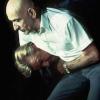Posted 21 October 2006 - 11:26 AM
I'd love to take a trip back to that era and walk down the street. As long as I wasn't Chinese, Native, Black, Japanese, female or any combination thereof!
I think zoomer found this Emily Carr quote:
"Victoria was like a lying-down cow, chewing. She had made
one enormous effort of upheaval. She had hoisted herself
from a Hudson's Bay Fort into a little town and there
she paused, chewing the cud of imported fodder, afraid
to crop the pastures of the new world for fear she might
lose the good flavour of the old to which she was so
deeply loyal. Her jaws went rolling on and on, long after
there was nothing left to chew."
[Emily describes the above area:]
On the corner of Humboldt and Blanshard stood the Reformed
Episcopal Church; criss-cross from it was the White Horse
Saloon. A great brick drain ran under Blanshard Street,
gushing into the slough which rambled over the mud flats
and out to the sea. Above the flats on the Belville Street
side were Governor Douglas's and Doctor Helmcken's houses.
There was always plenty to be seen from the high sidewalk.
The Reformed Episcopal Sunday School was beside the
church. It was sure to be either going in or coming out
as we passed. There were splendid slides on either side
of its steps which must have spoiled heaps of boys' Sunday
pants. Below the schoolhouse was a jungle of sweet-briar
rose bushes and then came the mud, covered round the
edges with coarse marsh grass.
There were nearly always Indians camped on the Flats.
They drew their canoes up the slough. Some camped right
in their canoes with a canvas tent across the top, some
pitched tents on the higher ground. The smoke of their
camp fires curled up. Indians loved camping here because
for many, many years the mud flats were used as the town's
rubbish dump. Square blue carts backed to the edge of
Blanshard Street and spattered their loads overboard--old
clothes, old stoves, broken baby buggies, broken crockery
and beds. The Indians picked it all over, chose what they
could use, stowed it away in their canoes to take to
their houses. When the tide came up and flooded the slough
and flats the canoes slipped away, the Indians calling
to their dogs who lingered for a last pick among the
rubbish. Then they waded through the mud and caught up
with the canoes just before they reached the sea. You
got excited watching to see if they'd make it.
The last and very meanest pick of all the rubbish was
left to the screeching seagulls that swooped for the
dregs of refuse, rising triumphant as kings with new
crowns.
[Here's some more of Emily telling it like it is. Down with nostalgia!! :D ]
From our own gate to the James' Bay Bridge wild
rose bushes grew at the roadsides nearly all the way and
their perfume was delicious. Then we came to the mud
flats and our noses hurt with its dreadfulness when the
tide was out. We had no sooner got over that than there
was Chinatown with stuffy, foreign smells. Then came the
gas-works--this smell was said to be healthful but it
was not nice. Rock Bay Bridge had more low-tide smells,
which were made easier by a sawmill; the new sawdust
smelled so nice that you forgot your nose until the other
end of the bridge came. There sat a tannery from which
came, I thought, the worst smell of them all. There was
one still more dreadful--Parker's slaughter-house and
piggery--but that was two miles further on and we did
not have to pass it on the way to call on our friends.
"Beaver, ahoy!""The bridge is like a magnet, attracting both pedestrians and over 30,000 vehicles daily who enjoy the views of Victoria's harbour. The skyline may change, but "Big Blue" as some call it, will always be there."
-City of Victoria website, 2009














